Indiana's Personal Income Grew but Its Share of the Nation Fell
The newest Bureau of Economic Analysis (BEA) data on state personal income present a mixed picture for Indiana. On the bright side, Hoosiers' personal income in the third quarter of 2006 was up by $2.7 billion over the previous quarter. On the other hand, Indiana's share of total U.S. personal income fell to 1.89 percent, its lowest level on record.
Figure 1 shows the generally downward trajectory of Indiana's personal income share over nearly 59 years. During the booming post-war years when the nation's factories resumed serving consumer markets after years of defense-focused production, Hoosiers' share of the nation's income tended to grow, peaking at 2.81 percent in 1953 before commencing a long, gradual decline. The Rust Belt flight of the late 1970s and 1980s hit Indiana quite hard, but the early 1990s brought a glimmer of hope for a short while. Indiana residents lost ground during the economic boom of the late 1990s, however, with their share of the nation's personal income falling again.
Figure 1: Indiana's Share of U.S. Personal Income, 1948 to 2006
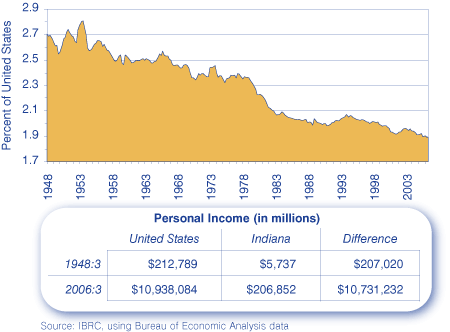
This is a familiar story with familiar reasons for our long-term relative shrinkage. Indiana's population is growing slowly (well under 1 percent annually), while many parts of the nation have much faster-growing populations, and thus more people to generate income. As the nation's economy continues its long transition from manufacturing to services, the general loss of factory jobs has hit Indiana especially hard, since it has a larger share of its workforce in this sector than any other state.
Our 1.33 percent income growth during the most recent quarter was not far behind the national figure of 1.39 percent, but 30 states experienced faster income growth than Indiana during the quarter. Examining year-over-year changes, Indiana's personal income grew by 5.14 percent from the third quarter of 2005 to the same period in 2006, whereas the U.S. total grew by 6.73 percent. During this period, 40 states' incomes grew at a faster rate than Indiana's rate.
Figure 2 compares Indiana and U.S. percent growth in personal income over the past four quarters. The nation's personal income growth significantly outpaced Indiana's in two quarters, while Indiana held the lead at the beginning of 2006 and they were nearly even in the most recent quarter.
Figure 2: Quarterly Growth in Personal Income, 2005:4 to 2006:3
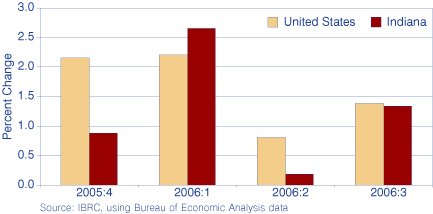
Regional Doldrums
Our neighbors in the Great Lakes states provide some comfort to the extent that misery loves company. This region had the slowest personal income growth (5.16 percent) of any BEA region over the past four quarters, barely edging out New England for this dubious distinction. As Figure 3 shows, Indiana enjoyed the second-best personal income growth among Great Lakes states, surpassed only by Illinois' respectable growth of 6.43 percent (the 18th best in the nation).
Figure 3: Personal Income Growth in the Great Lakes States, 2005:3 to 2006:3
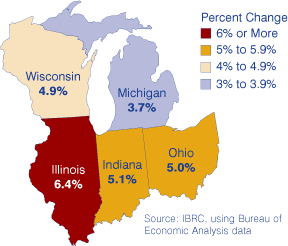
Contributions to Personal Income Growth
What accounts for Indiana's relatively slow income growth over the past year? Some insight is offered by examining the components of personal income. Personal income is the sum of three major components: earnings (wages and salaries, supplements to wages and salaries, and proprietors' income), returns to capital (dividends, interest and rent received by persons), and transfer payments (government payments to individuals other than for labor, such as Social Security and welfare, Medicare and Medicaid, unemployment insurance, veterans benefits and the like).
As seen in Figure 4, Hoosiers kept pace with the nation over the past four quarters in growth of income from interest, dividends and rents, which contributed about a third of a percentage point to our personal income growth. We outpaced the United States slightly with regard to growth in transfer receipts; unfortunately, data are not yet available to evaluate which types of transfer payments were responsible. The component of personal income with respect to which Indiana's growth (0.69 percent) most lagged the nation (0.76 percent) was earnings.
Figure 4: Contributions to Personal Income Growth, 2005:3 to 2006:3
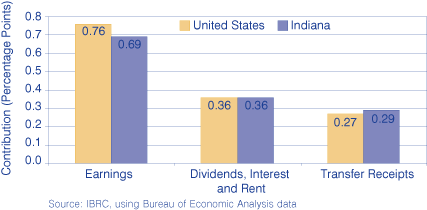
Contributions to Earnings Change
Since earnings were responsible for much of the growth gap between Indiana and the nation, we look next at the sectors from which those earnings were derived. Figure 5 compares Indiana and the United States in terms of contribution to change from the second quarter to the third quarter of 2006 in total earnings derived from each economic sector. Several contrasts between state and national earnings contributions are immediately evident.
Figure 5: Contribution to Percent Change in Earnings, 2006:2 to 2006:3
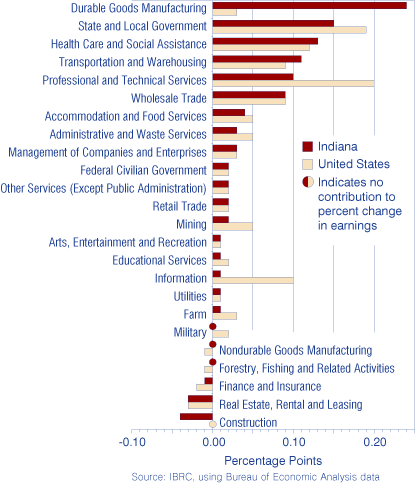
While the U.S. growth in earnings from durable goods manufacturing was quite small, in percentage terms, Indiana's was eight times as large. In fact, Indiana accounted for nearly 15 percent of the entire national gain in earnings from durable goods manufacturing despite continued job losses in this sector. These contrary movements reflect the recent GM and Delphi buyouts, which boosted personal earnings substantially.
Indiana earnings growth lagged well behind the nation in several other sectors, notably state and local government, professional and technical services, the relatively small information and mining sectors, and construction. Sectors for which Indiana's earnings growth led the nation, though by relatively small amounts, were healthcare and social assistance as well as transportation and warehousing; we might add that earnings of Hoosiers from the finance and insurance sector shrank at a slower rate than for the nation as a whole.
Jerry Conover, Director
Indiana Business Research Center, Kelley School of Business, Indiana University
